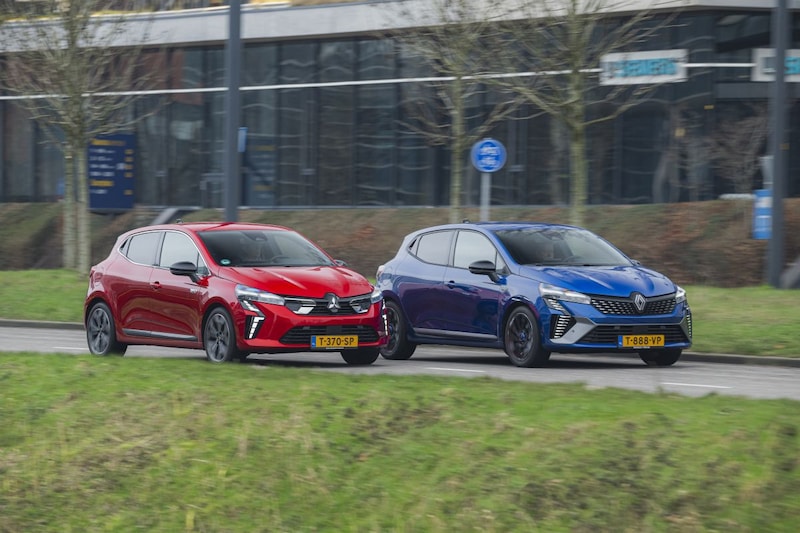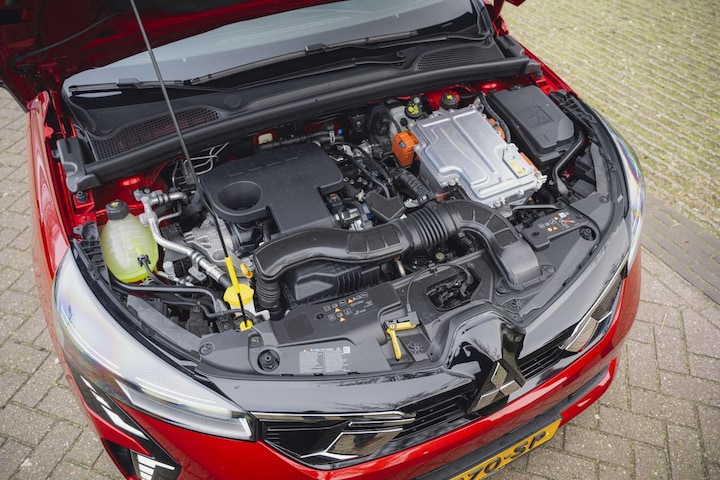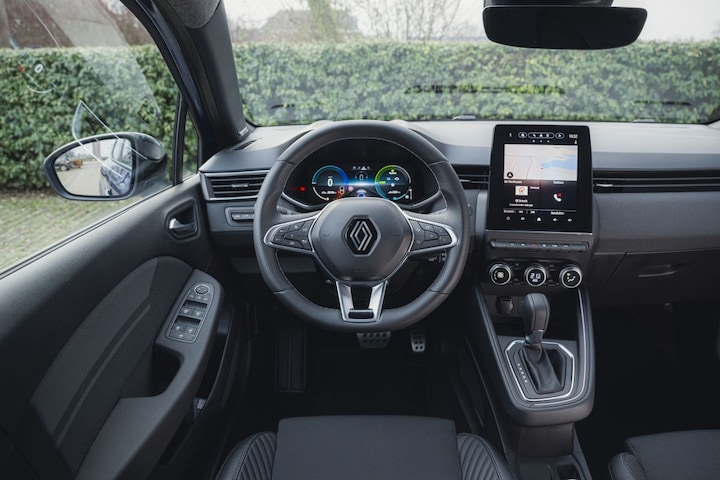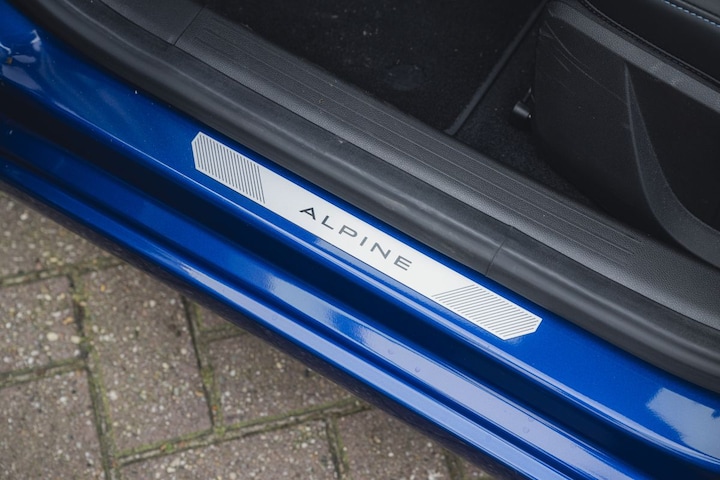Same except for the price

The new Mitsubishi Colt Hybrid looks familiar, you say? That’s right. The Mitsubishi in this test is actually the same car as the Renault Clio Hybrid in this test. Apart from the logos, the Mitsubishi Colt is identical. Or not?
It is not surprising that the Mitsubishi Colt Hybrid looks a lot like the Renault Clio Hybrid. Volkswagen builds the Golf, Audi builds the A3 with many of the same parts. Especially if brands belong to the same group, it would not make sense to do it in a different way. One step further than that is something with a nice English term badge engineering is called. Then two brands supply the same car, which are the same except for the logo. That is exactly what Mitsubishi is now doing with the new Colt. That is after the name a Renault Clio. Even identical twins are more different from each other. So time for a game of ‘spot the differences’
Complicated hybrid in Mitsubishi Colt and Renault Clio
There are differences between the Renault Clio Hybrid and Mitsubishi Colt Hybrid, although this depends more on the choices that the respective importers make with regard to their model range. To give an example: Renault’s range kicks off with the well-known 1.0 three-cylinder turbo engine, while Mitsubishi also supplies the Colt (or, well, has it in the price list) with a naturally aspirated 1.0. That is just as much a Renault engine and Renault also supplies it in the Clio elsewhere in the world, but not with us. What Renault does offer is an LPG version of the 1.0 turbo and that is therefore not in Mitsubishi’s price list. You can get the 1.0 turbo on petrol only and the hybrid powertrain from both brands.

In this case we have the hybrid in both the Mitsubishi Colt and the Renault Clio in this test and that is a fairly special piece of technology. The front wheels are driven by a naturally aspirated 1.6-liter four-cylinder with 94 hp. The gearbox in between has four ratios, but there is no clutch. Instead, the gearbox can shift thanks to an electric motor that removes the power from the drivetrain. Shifting is done by an electro-hydraulic unit. But we’re not there yet, because there is also a 49 hp electric motor that transmits power to the same front wheels via its own two-speed gearbox. Sounds complicated and it is. It also sometimes results in strange sensations. For example, you may feel that you are shifting gears, while the 1.6 just keeps climbing the revs, or that the 1.6 actually revs quite a lot to generate energy for the electric motor, while you are cruising through the city at 40. As if you keep driving in ‘1’ for too long. In addition, the shifting is sometimes a bit clumsy. To some extent you have influence on it yourself, the drivetrain works best if you take it easy. Don’t suddenly ask for more power, for example. When you drive it like this, the two power sources alternate neatly, the performance is still reasonable thanks to the 205 Nm of the electric motor and you can still save almost 1 in 20 even in winter. Neat, but not a huge jump compared to, for example, Toyota’s hybrid system. There are no real differences between the Clio and the Colt in this area.
Censorship on board the Mitsubishi Colt
Of course, there are roughly the same differences on the inside of the Mitsubishi Colt and Renault Clio as on the outside. That is to say: the logos are different and that’s about it. Ironically, Mitsubishi has taken the trouble to convert the Clio to Colt in the driving mode menu in the central screen, but applies a form of censorship in the digital instruments. There, a Clio ‘drives’ in the Clio, including the Renault logo. However, the back of the Colt is simply made black, so you only see a very vague outline of a car. And turn signals if you use them, which makes the whole thing a bit clumsy. Another difference is that the Clio is available in a so-called Esprit Alpine version. That is of course 95 percent a marketing hairball that the illustrious brand itself has nothing to do with, but it does result in very nice sports seats that you cannot get in the Colt.


Anyway: because the Colt and the Clio are otherwise identical in the interior, it is by far the most beautiful Colt ever. The ergonomics are quite good. There are plenty of physical buttons and the latest generation of Renault’s multimedia system is a huge step forward from before. Good: it is still not extremely logical, but the number of layers and submenus has been greatly reduced, making it less likely that you get lost in the system. That is of course also good news for safety. An adult can sit very comfortably on the back seat and there is also a very decent luggage space for the segment. It is striking that both brands communicate different values in the price list. Mitsubishi specifies 301-979 liters, Renault keeps it at 318 liters for the Clio. Perhaps both brands apply slightly different standards, but based on our eyes and our measuring tape, no difference can be detected.
 Comfortable Renault Clio also comfortable Mitsubishi Colt
Comfortable Renault Clio also comfortable Mitsubishi Colt
Given the French approach, you expect a lot of comfort from the chassis and the Renault Clio and the Mitsubishi Colt do not disappoint. The chassis absorbs a lot and gives in a pleasant way on bad road surfaces and over speed bumps, without giving you the feeling of losing contact with the road surface. The control filters out a lot but works with sufficient counter pressure and directness. It is all neatly balanced and makes the Clio (and therefore also the Colt) a very mature car for the B-segment. In this part there are no differences between the two cars. So don’t be fooled by the Alpine trim of the Clio, because as mentioned earlier, Dieppe had nothing to do with the Clio. We often see that cars in this segment receive more stickers than actual mechanical upgrades, but Renault is making a big deal here. They didn’t even bother to put the Esprit Alpine on a slightly different tire. And Ecocontacts do have qualities, but sportiness does not belong to that category. As for the bat, we’re glad Mitsubishi didn’t steal this idea and not supply a Ralliart version of the Colt.
Choices for the Renault Clio and Mitsubishi Colt
Well, real sportiness may be lacking, but the Esprit Alpine is also the most luxurious version of the Renault Clio. However, this does not immediately mean that the Renault is completely finished, because even on the top version, Renault still has something to choose from. For example, seat and steering wheel heating are not standard and a 360-degree camera or Bose sound system are still on the options list, as are most paint colors. Many safety systems, navigation, 17-inch alloys and a reversing camera are standard. Including options, our test Clio costs no less than €31,050.
As mentioned, there is no Ralliart version of the Mitsubishi Colt. Instead, the French Mitsubishi comes in three versions: Intense, First Edition and Style. There is also a fourth version, the Pure, but it is only available with the basic engine and is therefore the showroom lure. Apart from those versions and the color, there is nothing to choose from, which keeps it nice and clear. In this case we have the First Edition and it is actually neatly packed. The active safety systems common for this segment are all present, as well as luxuries such as seat and steering wheel heating, 17-inch alloys and an armrest between the front seats. The price of such a First Edition with metallic paint is €30,790. Slightly cheaper than the Clio, but then you don’t have all the sporty looks. Because Mitsubishi and Renault make slightly different choices with regard to model policy, it is difficult to dress the cars exactly the same. The only way to do that is to choose the most luxurious Instyle at Mitsubishi and to completely load the mid-equipment Techno with option packages at Renault. Then both cars come in at just over 32,000. What always differs is the warranty period. Renault promises two years without mileage limits, Mitsubishi promises five years or 100,000 kilometers. If you also take your Colt to the dealer for maintenance every year, Mitsubishi will extend the warranty period by three years and 60,000 kilometers. And so the Colt may not be better than its identical twin brother, but it does seem more reliable at first glance.

– Thanks for information from Autoweek.nl